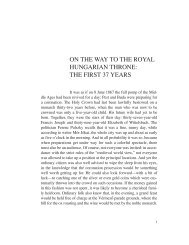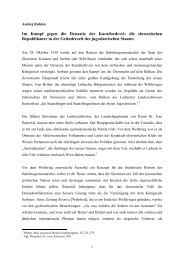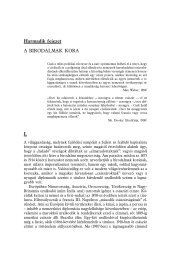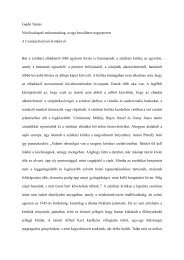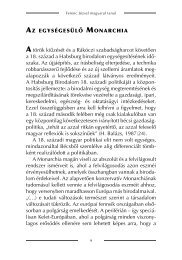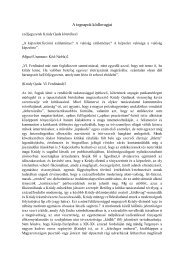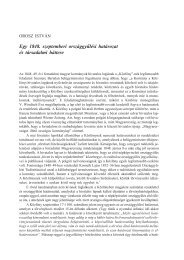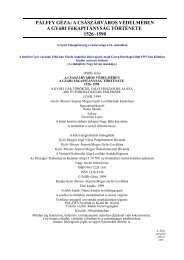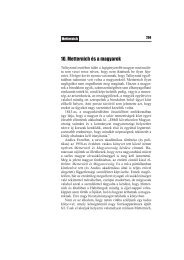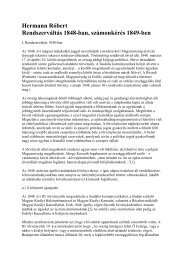Estates and Frontier Castles
Estates and Frontier Castles
Estates and Frontier Castles
Sie wollen auch ein ePaper? Erhöhen Sie die Reichweite Ihrer Titel.
YUMPU macht aus Druck-PDFs automatisch weboptimierte ePaper, die Google liebt.
Habs sor 02-2.qxd 2008. 08. 15. 11:21 Page 659<br />
ISTVÁN KENYERES<br />
<strong>Estates</strong> <strong>and</strong> <strong>Frontier</strong> <strong>Castles</strong><br />
Chamber <strong>Estates</strong> <strong>and</strong> Defence System Against<br />
the Ottomans in the Kingdom of Hungary<br />
in the 16th Century<br />
The 16 th century history of the royal <strong>and</strong> court chamber estates can be<br />
associated with two determining phenomena of the early modern history<br />
of the Hungarian Kingdom: the building of the frontier castle system<br />
against the Turks <strong>and</strong> the introduction of modern Habsburg state administration.<br />
The book analyses the system of administration of royal private estates<br />
in the late Middle Ages <strong>and</strong> follows their development after the<br />
Mohács era (1526): the abolition of the queen’s system of estates <strong>and</strong> the<br />
renewal of the king’s private estate system (1548). Parallel to these<br />
changes, the system of court chamber estates evolved. This was one of<br />
the decisive elements of the governance reform introduced by Ferdin<strong>and</strong> I<br />
(1526–1564). This estate system, developed in the mid-16 th century,<br />
played a decisive role in the estate structure of the country; by the end<br />
Ferdin<strong>and</strong> I’s reign the proportion of court chamber estates surpassed<br />
that of the royal estates previously in the h<strong>and</strong>s of Hunyadi Mátyás<br />
(1458–1490).<br />
The book presents main characteristics of the role of the early modern<br />
history estate, its administration <strong>and</strong> management in the broader context<br />
of the three main Treasury/Court Chamber-owned estate categories.<br />
These are: a) Treasury-owned properties managed by the Court Chamber<br />
b) in the “private property” of the king <strong>and</strong> c) vacant properties or<br />
properties of the Church taken over for the purpose of the state.<br />
The author argues that the majority of the centers of estates of the<br />
chamber were simultaneously important frontier castles supplied by the<br />
659mm
Habs sor 02-2.qxd 2008. 08. 15. 11:21 Page 660<br />
Uradalmak<br />
és végvárak<br />
court chamber estates. The Habsburg governance introduced in Hungary<br />
the management of the court chamber estates, which were considered<br />
progressive for this time period. The court chamber estates established<br />
by the Habsburgs’ were based on Hungary’s medieval system of estate<br />
management; medieval estate administrators evolved into state officials.<br />
Detailed instructions regulated their duties <strong>and</strong> competence.<br />
This book, which is an excellent achievement in the historiography of<br />
the Hungarian governance <strong>and</strong> economy, provides insight into the management<br />
<strong>and</strong> economy of ten essential estates giving multiple unique additional<br />
information to the research of the contemporary everyday life.<br />
Organization, management <strong>and</strong> economy of the early modern history estates<br />
such as the Trencsén (Trenèín, Slovakia) castle owned by the Szapolyai<br />
<strong>and</strong> Thurzó families <strong>and</strong> the late medieval <strong>and</strong> mid-16th century<br />
history conditions of Magyaróvár <strong>and</strong> Zólyom (Zvolen, Sl.) owned by<br />
Maria Habsburg are included. At the same time there is an encompassing<br />
analysis on the pre-Mohács royal estate of Komárom (Komarno, Sl.).<br />
Moreover the reader will find detailed descriptions not only of the the<br />
classical court chamber castle estates, but also that of Tokaj, famous for<br />
its wine growing <strong>and</strong> one of the largest court chamber estates, Szatmár<br />
(Satu Mare, Rumania). In order to follow the principle of regions, the<br />
book provides detailed description of the two very important Transdanubian<br />
castles <strong>and</strong> estates, those of Szigetvár <strong>and</strong> its successor Kanizsa.<br />
A separate set of questions is dealt with concerning the estates owned by<br />
the Church but administered by the court chamber. The administration<br />
<strong>and</strong> management of two of these estates is treated in detail: the Bishopric<br />
of Eger, which supplied the border castle of Eger, <strong>and</strong> the large estate of<br />
Archbishopric of Esztergom, which supplied the castle of Érsekújvár<br />
(Nové Zámky, Sl.). One of the central problems of that time was supplying<br />
<strong>and</strong> providing food to the military of border castles against the<br />
Turks. The backbone of this system was provided by the Treasury <strong>and</strong><br />
court chamber estates. The book details the development of food provision<br />
system of the border castles <strong>and</strong> how it closely paralleled the system<br />
of the court chamber administration of estates.<br />
When dealing with the administration of the court chamber <strong>and</strong> that of<br />
the estate, it is also necessary to also evaluate the career of the officials.<br />
The book presents a brief overview of one of the first mass strata of state<br />
officials (very rarely coming from burghers but mostly from small <strong>and</strong><br />
middle nobility) of early modern Hungarian history <strong>and</strong> clarifies the motivation<br />
<strong>and</strong> career possibilities of these elite officials who took their part<br />
in the administration of the estates <strong>and</strong> food provision of the castles.<br />
660mm
Habs sor 02-2.qxd 2008. 08. 15. 11:21 Page 661<br />
ISTVÁN KENYERES<br />
Grundherrschaften und Grenzfestungen<br />
Die Kammerherrschaften und die Türkenabwehr<br />
im Königreich Ungarn des 16. Jahrhunderts<br />
Die Entwicklung der Grundherrschaften des Königs, der Königin und der<br />
Kammer im 16. Jahrhundert ist untrennbar mit zwei zentralen Phänomenen<br />
der frühneuzeitlichen Geschichte des Königreichs Ungarn verbunden: mit<br />
dem Ausbau des Grenzfestungssystems gegen die Türken und mit der<br />
Einführung der frühneuzeitlichen Staatsverwaltung durch die Habsburger.<br />
Nach einer Darstellung der spätmittelalterlichen Domänen (Grundherrschaften)<br />
des Königs und der Königin untersucht der B<strong>and</strong> die<br />
Entwicklung der Zeit nach der Schlacht von Mohács. In einem längeren<br />
Prozess wurde das Gutsystem der Königin Maria, der Witwe des letzten<br />
jagiellonischen Königs Ludwig II., in königliche Grundherrschaften<br />
umgew<strong>and</strong>elt (1548). Parallel dazu begann der Ausbau des Kammerherrschaftssystems,<br />
der eines der entscheidenden Elemente der Verwaltungsreformen<br />
Ferdin<strong>and</strong>s I. (1526–1564) bildete. Die Kammerherrschaften,<br />
etabliert bis in die 1550/60er Jahre, spielten innerhalb der Besitzstruktur<br />
des L<strong>and</strong>es eine grundlegende Rolle: Bis zum Ende der Regierung<br />
Ferdin<strong>and</strong>s I. übertraf der Anteil dieser Herrschaften und der königlichen<br />
Domänen sogar die Anzahl der Güter, die sich in der Zeit von Matthias<br />
Hunyadi/Corvinus (1458–1490) im königlichen Besitz befunden hatten.<br />
Die vorliegende Studie untersucht die Verwaltung und Ökonomie des<br />
frühneuzeitlichen Großgrundbesitzes anh<strong>and</strong> der drei wichtigsten Gruppen<br />
von Fiskal- und Kammergütern im weitesten Sinn: a) von Gütern im Besitz<br />
des Fiskus und unter der Verwaltung der Kammer, b) von Gütern im<br />
königlichen „Privateigentum“ (Domänen), und c) von vakanten oder für<br />
staatliche Zwecke übernommenen Kirchengütern. Einen wichtigen Aspekt<br />
bildet der Umst<strong>and</strong>, dass die Zentren der meisten Kammergüter gleichzeitig<br />
auch bedeutende Grenzfestungen waren, zu deren Versorgung die Grundherrschaften<br />
dienten. Die habsburgische Regierung führte in Ungarn die zu<br />
Beginn der Frühen Neuzeit moderne Kammerverwaltung ein, dessen unterste,<br />
lokale Ebene die Güter bildeten. Bei der Errichtung dieses frühmodernen<br />
661mm
Habs sor 02-2.qxd 2008. 08. 15. 11:21 Page 662<br />
Uradalmak<br />
és végvárak<br />
Verwaltungssystems baute die habsburgische Administration auf der mittelalterlichen<br />
ungarischen Verwaltungsorganisation auf: Die mittelalterlichen Verwalter,<br />
die Dienstleute der Feudalherren (familiaris) waren, w<strong>and</strong>elten sich in<br />
Staatsbeamte. Ihre Aufgaben und Kompetenzen wurden durch detaillierte<br />
Instruktionen geregelt. Sie bilden einen Teil der breiten und auf der Überlieferung<br />
des Ungarichen Staatsarchives und des Österreichischen Staatsarchives<br />
basierenden archivalischen Quellengrundlage dieser Untersuchung.<br />
Erstmals in der Historiografie zur ungarischen Geschichte der beginnenden<br />
Neuzeit bietet der B<strong>and</strong> Einblick in die Verwaltung und Ökonomie<br />
von zehn bedeutenden Grundherrschaften. Umfassend dargestellt werden<br />
Organisation, Verwaltung und Wirtschaft der Herrschaften Trentschin<br />
(Trenèín, heute Slowakei), im Besitz der Magnaten-Familien Szapolyai und<br />
Thurzó, Ungarisch-Altenburg (Magyaróvár, Ungarn) und Altsohl (Zvolen,<br />
Sl.), beide im Besitz von Maria von Habsburg, sowie der auch in der Zeit<br />
vor Mohács königlichen Grundherrschaft Komorn (Komarno, Sl.). Zu den<br />
untersuchten „klassischen“ Kammerherrschaften gehören neben<br />
Trentschin auch die wegen ihres Weinbaus berühmte Grundherrschaft von<br />
Tokaj und das äußerst umfangreiche Kammergut von Szatmár (Satu Mare,<br />
Rumänien). Aus dem südwestlichen Ungarn werden die beiden wichtigsten<br />
Festungen und Güter Szigetvár und Kanizsa ausführlich beschrieben.<br />
Die unter Kammerverwaltung stehenden großen Kirchengüter bilden<br />
ein separates Thema. Im Zentrum stehen hier die Verwaltung und Wirtschaft<br />
des Bistums Erlau (Eger, U.), das die gleichnamige Grenzfestung<br />
versorgte, und des riesige Gut des Erzbistums von Gran (Esztergom, U.),<br />
das zur Unterhaltung von Neuhäusel (Nové Zámky, Sl.) diente.<br />
Eines der Kernprobleme der Epoche bildete die Lebensmittelversorgung<br />
der auf den gegen die Türken errichteten Grenzfestungen stationierten<br />
Truppen. Die Basis dafür sicherten die Fiskal- und Kammergüter.<br />
Daher diskutiert der B<strong>and</strong> ausführlich die Einrichtung und Struktur der<br />
Organisation des Proviantwesens der Grenzfestungen (Obristes<br />
Proviantmeisteramt in Ungarn), die parallel zu dem damit vielfach verflochtenen<br />
Güterverwaltungssystem der Kammer ausgebaut und bis zum<br />
Ende des 16. Jahrhunderts konsolidiert wurde.<br />
Für eine Analyse der Verwaltung der königlichen und kameralen<br />
Grundherrschaften ist die Erforschung der damit beauftragten Amtsträger<br />
unerlässlich. Der B<strong>and</strong> bietet daher auch eine Übersicht über diese frühe,<br />
zahlenmäßig breite Beamtenschaft, sowie eine Darstellung der Motivation<br />
und Karrieremöglichkeiten dieser an der Administration der Güter oder der<br />
Verproviantierung der Grenzfestungen beteiligten und sich hauptsächlich<br />
aus dem niedrigeren und mittleren Adel rekrutierenden Funktionselite.<br />
662mm



